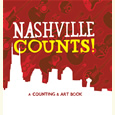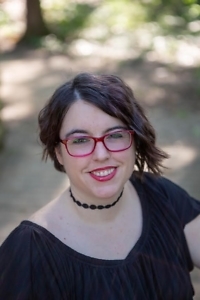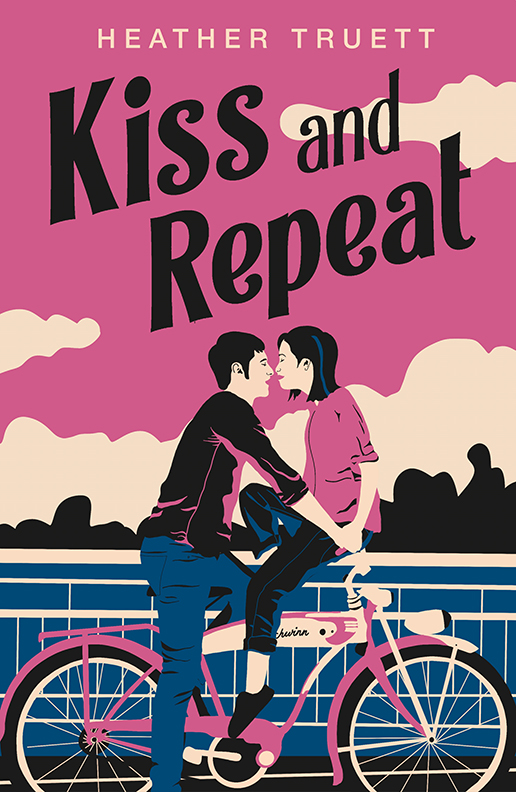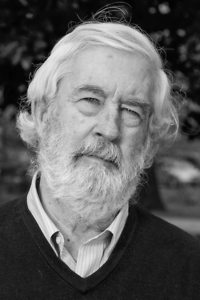Color Her Happy
Jessica Young’s debut picture book considers our emotional responses to color
My Blue is Happy, the new picture book by art teacher and Nashville resident Jessica Young, encourages young readers to look at familiar colors in a new way. Young’s plucky narrator first considers the interpretations of various colors offered to her by friends and family and then proceeds to chart her own course, defining each color based on her particular likes and dislikes. For instance, “The boy next door says red is angry / Like a dragon’s burning breath. / But my red is as brave as a fire truck / And my superhero cape.” Color-saturated acrylic paintings by Brazilian-born illustrator Catia Chien provide a corresponding visual narrative, as well as a touch of whimsy.
Prior to her appearance at Parnassus Books in Nashville on August 13, Jessica Young answered questions from Chapter 16 via email:
Chapter 16: What made colors—and the feelings associated with them—especially appealing to you as a book topic?
Young: I’ve always loved colors in a way that I can almost taste them. I remember thinking about blues music and Picasso’s Blue Period and imagining how many other associations for blue there might be. I also wondered how it would feel to realize your favorite color might be perceived in a totally different way by someone else.
The book is also about subjectivity—how people see the world through their own lenses. That idea has been of interest to me for a long time, too. Kids are often expected to act and think and feel a certain way. In making her observations about color, the free-spirited girl in My Blue quietly asserts her independence; she notices how others have different viewpoints, and then simply states her own. No one else can tell her what her blue is: it’s hers.
 Chapter 16: Do you ever test-market your story ideas on your own kids? If so, what were their reactions to My Blue is Happy?
Chapter 16: Do you ever test-market your story ideas on your own kids? If so, what were their reactions to My Blue is Happy?
Young: I do sometimes ask for my kids’ input, but I started this piece when they were pretty young. As it evolved, I remember talking about their associations and discussing parts of the story, but I don’t think I actually read them the whole thing until we had the printed version of the book. It’s such an illustration-dependent text—I wanted them to get the full experience, as well as seeing their names in the dedication. It was pretty amazing to have them read it to me for the first time.
Chapter 16: What book did you especially enjoy growing up or discover by reading to your children?
Young: There are so many! When I was little, I loved a Helen Oxenbury-illustrated version of The Quangle Wangle’s Hat by Edward Lear, Ferdinand, a lot of Sendak, especially the Nutshell Library stories, George and Martha, Crictor, Tico and the Golden Wings by Leo Lionni, Dr. Seuss… . I also had a Lisbeth Zwerger-illustrated version of The Gift of the Magi that I appreciated when I was a bit older.
Books I discovered when reading to my children include Birds by Kevin Henkes, Wave and Mirror by Suzy Lee, the Elephant & Piggie series by Mo Willems (especially Today I Will Fly!), Mole Music by David McPhail, The Quiet Book by Deborah Underwood, I Want My Hat Back by Jon Klassen, The House in the Night by Susan Marie Swanson, Bink & Gollie by Kate DiCamillo and Alison McGhee, The Invention of Hugo Cabret by Brian Selznick, Grandpa Green by Lane Smith, A Sick Day for Amos McGee by Philip and Erin Stead, The Red Tree by Shaun Tan, The Dot by Peter H. Reynolds—too many to name!
Chapter 16: How has your participation in the Society of Children’s Book Writers and Illustrators helped you in the writing or marketing of My Blue is Happy?
Young: SCBWI has really changed my life. In 2007 I went to my first SCBWI workshop, where an agent gave me detailed feedback on several manuscripts, including My Blue is Happy (and where I met a bunch of other people also trying to do what I was trying to do, which was exciting!). After that, the agent and I kept in touch as I worked on revisions for several pieces. Ultimately, she wasn’t looking to take on picture-book clients, but her encouragement was enough to keep me going until I found an agent who was perfect for me.
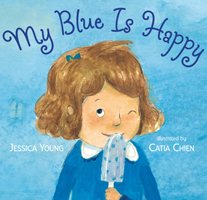 In 2009 I signed with my fantastic agent, Kelly Sonnack. With her keen editorial guidance I continued to revise, and we submitted My Blue to two editors who had seen previous versions and given comments. One of them had positive feedback but passed on it. The other editor who had seen it at an SCBWI workshop offered some suggestions, and I revised accordingly, creating two new versions. Yet I couldn’t seem to get it to feel right. As I struggled with the revisions, the Midsouth SCBWI conference came up and I decided to submit My Blue for a critique. I got Candlewick editor Kaylan Adair as my critiquer. She gave constructive comments that resonated with me and made suggestions I honestly didn’t think I’d be able to execute. But I could see that she really “got” the essence of the piece. I sat in the lobby of the hotel after the conference was over and started pushing and pulling the text around. About a month later we submitted it to her and after some pre-contractual revisions, she offered me a contract. I couldn’t believe it. In fact, I still can’t!
In 2009 I signed with my fantastic agent, Kelly Sonnack. With her keen editorial guidance I continued to revise, and we submitted My Blue to two editors who had seen previous versions and given comments. One of them had positive feedback but passed on it. The other editor who had seen it at an SCBWI workshop offered some suggestions, and I revised accordingly, creating two new versions. Yet I couldn’t seem to get it to feel right. As I struggled with the revisions, the Midsouth SCBWI conference came up and I decided to submit My Blue for a critique. I got Candlewick editor Kaylan Adair as my critiquer. She gave constructive comments that resonated with me and made suggestions I honestly didn’t think I’d be able to execute. But I could see that she really “got” the essence of the piece. I sat in the lobby of the hotel after the conference was over and started pushing and pulling the text around. About a month later we submitted it to her and after some pre-contractual revisions, she offered me a contract. I couldn’t believe it. In fact, I still can’t!
Even more importantly, SCBWI has helped me learn about writing and introduced me to people who value stories for children and the process of making them. I’ve met friends who push me and cheer me on, and who understand the challenges and celebrate the successes of finding an idea, completing a manuscript, or getting a contract. They read my work and help me make my pieces the best they can be, while keeping them the most “me” they can be. Looking back, I counted eighty-nine revisions of My Blue, not including the ones I didn’t save. There were so many directions I tried taking it, and I feel incredibly lucky to have had the help of wonderful critique partners and my incredible agent and editor to support me in getting to the final version. If I hadn’t had this team of folks, I would have given up.
Chapter 16: Any thoughts on the competition between paper-and-ink picture books and tablet apps for young children?
Young: The physicality of a book—the feel of the pages, the cover, the spine—can’t be replicated digitally, and neither can the experience of reading it. I think apps can be useful and fun, but I see them as totally different. For me, picture books are like collections of limited edition prints that make up a story. As a child surveys her bookshelf, chooses a book, and settles in with it, there’s a sense of security, beauty, and home that can’t be achieved by selecting an app. Many of my kids’ books were given on special occasions, or have inscriptions from family or friends, and that makes them especially meaningful. Going to the library for books is a wonderful ritual as well. So I guess I’d say each has its place, and there may be some overlap, but to me the worry is that, in the presence of this relatively new technology, people will forget the simple, timeless benefits of the book.
Chapter 16: What was the process like for you, as a visual artist yourself, of having your first book illustrated by another artist? Any plans to provide your own illustrations for future projects?
Young: I love making things with other people, and after revising, I was happy to pass off the text and see where someone else would take it. The illustrator, Catia Chien, brought her own associations and experience to the text and really transformed it. She created some evocative, beautiful images that I never would have come up with.
I did get my undergraduate degree in fine art, but I was mostly interested in large, layered oil paintings and sculpture. After I had my first child, writing took the place of visual art for me. Also, I’m always the last one to order from a menu (decision-making is sometimes difficult), so choosing from all of the illustration possibilities a text offers seems a daunting prospect. I still love to sketch or paint from time to time, but I don’t see myself attempting illustration in the immediate future. Maybe one day, but it would have to be the right book.
Chapter 16: What’s your next book project?
Young: I’m very excited about my next picture book, Spy Guy (Harcourt, spring 2015), and I’m always working on a bunch of other projects, including some longer ones.
Chapter 16: Finally, what is your own favorite color and why?
Young: It’s hard to pick just one! (See what I mean about the decision-making?) But if I had to, it would be blue—just like in the book. Because of my favorite jeans, swimming in the pool (or lake or ocean), sky, the cobalt blue of bottles, the stone lapis lazuli and its magical ultramarine blue. But I also love rusty, russet-y red-oranges; emerald, pear, and mossy greens; indigo; and silver.
Jessica Young will discuss My Blue is Happy at Parnassus Books on August 13, 2013, at 6:30 p.m., and at the twenty-fifth annual Southern Festival of Books, held in Nashville October 11-13. Both events are free and open to the public.

